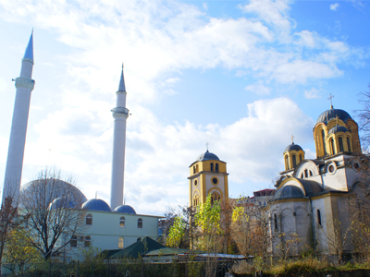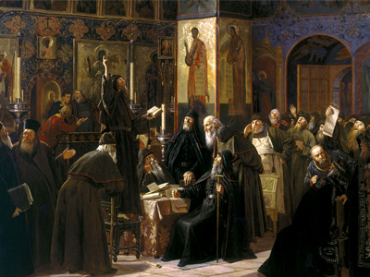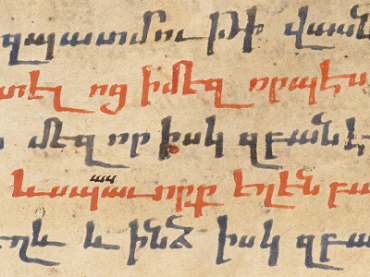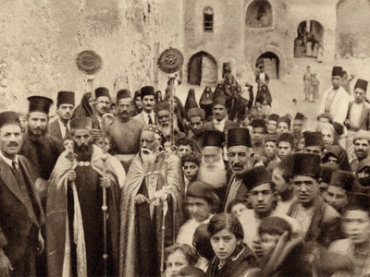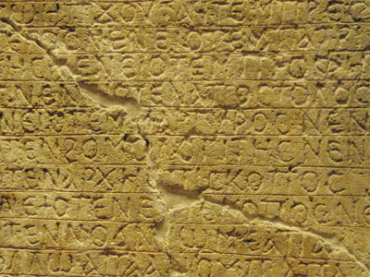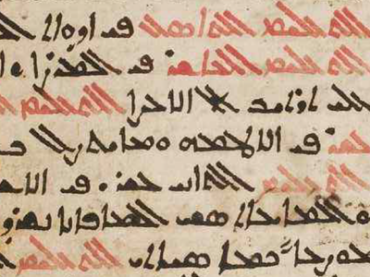Syriac and Eastern Christianity
Jacob of Sarug’s Homily on Epiphany
Metrical Homilies of Mar Jacob of Sarug
Translation and Introduction by Thomas Kollamparampil
Series: Texts from Christian Late Antiquity 4
ISBN: 978-1-59333-736-0
This edition of Mar Jacob of Sarug's (d. 521) homily on Epiphany discusses John the Baptist's role in washing the church, the bride of Christ, preparing and sanctifying her for the Bridegroom. The volume constitutes a fascicle of The Metrical Homilies of Mar Jacob of Sarug, which, when complete, will contain the original Syriac text of Jacob's surviving sermons, fully vocalized, alongside an annotated English translation.
$35.00
Jacob of Sarug’s Homily on Palm Sunday
Metrical Homilies of Mar Jacob of Sarug
Translation and Introduction by Thomas Kollamparampil
Series: Texts from Christian Late Antiquity 5
ISBN: 978-1-59333-737-7
This edition of Mar Jacob of Sarug's (d. 521) homily for Palm Sunday discusses Jesus’ entry into Jerusalem. The homily admonishes the hearers to perceive the benevolence of the divine self-abasement and recognize the Mighty One on the humble streets of Jerusalem. The volume constitutes a fascicle of The Metrical Homilies of Mar Jacob of Sarug, which, when complete, will contain the original Syriac text of Jacob's surviving sermons, fully vocalized, alongside an annotated English translation.
$30.00
Bar Hebraeus' Book of the Pupils of the Eye
Series: Analecta Gorgiana 45
ISBN: 978-1-59333-859-6
The Book of the Pupils of the Eye is Bar Hebraeus’s introduction to Aristotle’s Organon. This volume makes the Sryiac text available to the interested scholar or student.
$59.00
Bardaisan and the Odes of Solomon
Series: Analecta Gorgiana 46
ISBN: 978-1-59333-860-2
A compelling discussion of the origins and authorship of the Odes of Solomon, this work provides great insight into the person of Bar Daysan as well as the research surrounding the text of the Odes of Solomon.
$41.00
Islam Corrects Judaism
The Polemics of a Thirteenth Century Jewish Convert
Series: Analecta Gorgiana 47
ISBN: 978-1-59333-862-6
Herein a 13th century Alexandrian Jewish convert to Islam records his understanding of the truth of Islam over Judaism. Dr. Sidney A. Weston edits, translates and comments on this text making it accessible to the scholar and enthusiast alike.
$48.00
Tracing the Bridegroom in Dura
The Bridal Initiation Service of the Dura-Europos Christian Baptistery as Early Evidence of the Use of Images in Christian and Byzantine Worship
ISBN: 978-1-59333-738-4
This book examines the previously unexplored sources of the eleventh-century Byzantine service of Christ the Bridegroom by locating its origins in the liturgical environment of third-century Christian Syria and Mesopotamia, and especially in the baptistry of the Christian House at Dura-Europos, as well as in the texts of the Acts of Thomas, the Gospel of Philip and the Symposium by Methodius of Olympus. More specifically, Pagoulatos analyzes the bridal initiation service (the earliest known Iconophile service) of the Dura-Europos baptistery, focusing on the role that the images played in it.
$78.00
The Acts of Saint George and the Story of his Father
From the Syriac and Garshuni Versions
ISBN: 978-1-59333-784-1
One of the most enduring of the saints, Saint George has seldom failed to capture the imagination of Christian readers, both ancient and modern. The Acts of Saint George, originally written in Greek, quickly spread to many linguistic traditions in the church of late antiquity. Presented here in vocalized Syriac and Arabic, the original text of the Acts is made easily accessible to readers of these languages. A detailed introduction in English summarizes the hagiography for those unacquainted with the Semitic languages. The account follows the hagiographic practice of describing the trials, steadfast faith, and martyrdom of the saint. Also included is the story of the father of Saint George, recorded in Syriac.
$60.00
Les Dialectes Néo-Araméens de Salamas
Textes sur l’état actuel de la Perse et contes populaires
Series: Kiraz Historical Grammars Archive 12
ISBN: 978-1-59333-787-2
This specialized study by renowned linguist Rubens Duval brings together several grammatical studies between its covers. For the most part this intriguing volume is an exploration of the dialects of Neo-Aramaic of Salmas in the area of Azerbaijan and northwest Iran. Duval transcribed in handwritten, Roman characters, the aural information he received in the region from Syrian Christians and Jews. These are translated into French, making access to the linguistic information available to non-Semitic specialists. Duval concludes the book with an article on Syriac inscriptions of Salmas. This book is very rare in the used book market.
$165.00
History of the Monastery of Saint Matthew in Mosul
Translated by Matti Moosa
ISBN: 978-1-59333-788-9
Located north of Mosul, St. Matthew’s Monastery—commonly known as Dayr Sheikh Matti—is perhaps the most ancient religious institution in Iraq. Although the Syriac life story of St. Matthew was published together with that of St. Behnam by Paul Bedjan in 1891, and translated into Arabic by Elias Behnam, this present account is more extensive and informative. It includes in-depth physical and spiritual descriptions of the monastery as an outstanding institution which played a significant role in the history of the Syrian Orthodox Church of the East. Mar Ignatius Jacob III offers insight into the monastery’s learned superiors, metropolitans and magnificent library.
$145.00
The Christians of St. Thomas and Their Liturgies
Series: Kiraz Liturgical Studies 1
ISBN: 978-1-59333-800-8
Originally written to inspire sympathy for their Eastern Christian compatriots among the membership of the Church of England, Howard’s study has become a touchstone for those seeking a sense of antique Christian liturgical practice. After providing a history of the “St. Thomas Christians,” the Orthodox Christians of India, up until the mid-nineteenth century, Howard presents English translations of six different anaphorae in use in Christendom: namely, those of St. James, St. Peter, The Twelve Apostles, Mar Dionysius Barsalibi, Mar Xystus, and Mar Evannis.
$171.00
Hugoye - Journal of Syriac Studies (Volume 1)
1998 [2010]
Edited by George Anton Kiraz
Series: Hugoye: Journal of Syriac Studies 1
ISBN: 978-1-59333-810-7
Widely regarded as a premier journal dedicated to the study of Syriac, Hugoye: Journal of Syriac Studies was established in 1998 as a venue devoted exclusively to the discipline. An organ of Beth Mardutho, the Syriac Institute, the journal appears semi-annually and will be printed in annual editions. A peer-reviewed journal, Hugoye is a respected academic source for up-to-date information about the state of Syriac studies and for discovering what is going on in the field. Contributors include some of the most respected names in the world of Syriac today. This is Volume 1 of the journal from 1998.
$75.00
Hugoye - Journal of Syriac Studies (Volume 2)
1999 [2010]
Edited by George Anton Kiraz
Series: Hugoye: Journal of Syriac Studies 2
ISBN: 978-1-59333-811-4
Widely regarded as a premier journal dedicated to the study of Syriac, Hugoye: Journal of Syriac Studies was established in 1998 as a venue devoted exclusively to the discipline. An organ of Beth Mardutho, the Syriac Institute, the journal appears semi-annually and will be printed in annual editions. A peer-reviewed journal, Hugoye is a respected academic source for up-to-date information about the state of Syriac studies and for discovering what is going on in the field. Contributors include some of the most respected names in the world of Syriac today. This is Volume 2 of the journal from 1999.
$75.00
Hugoye - Journal of Syriac Studies (Volume 3)
2000 [2010]
Edited by George Anton Kiraz
Series: Hugoye: Journal of Syriac Studies 3
ISBN: 978-1-59333-812-1
Widely regarded as a premier journal dedicated to the study of Syriac, Hugoye: Journal of Syriac Studies was established in 1998 as a venue devoted exclusively to the discipline. An organ of Beth Mardutho, the Syriac Institute, the journal appears semi-annually and will be printed in annual editions. A peer-reviewed journal, Hugoye is a respected academic source for up-to-date information about the state of Syriac studies and for discovering what is going on in the field. Contributors include some of the most respected names in the world of Syriac today. This is Volume 3 of the journal from 2000.
$75.00
Hugoye - Journal of Syriac Studies (Volume 4)
2001 [2010]
Edited by George Anton Kiraz
Series: Hugoye: Journal of Syriac Studies 4
ISBN: 978-1-59333-813-8
Widely regarded as a premier journal dedicated to the study of Syriac, Hugoye: Journal of Syriac Studies was established in 1998 as a venue devoted exclusively to the discipline. An organ of Beth Mardutho, the Syriac Institute, the journal appears semi-annually and will be printed in annual editions. A peer-reviewed journal, Hugoye is a respected academic source for up-to-date information about the state of Syriac studies and for discovering what is going on in the field. Contributors include some of the most respected names in the world of Syriac today. This is Volume 4 of the journal from 2001.
$75.00
Hugoye - Journal of Syriac Studies (Volume 5)
Edited by George Anton Kiraz
Series: Hugoye: Journal of Syriac Studies 5
ISBN: 978-1-59333-814-5
Widely regarded as a premier journal dedicated to the study of Syriac, Hugoye: Journal of Syriac Studies was established in 1998 as a venue devoted exclusively to the discipline. An organ of Beth Mardutho, the Syriac Institute, the journal appears semi-annually and will be printed in annual editions. A peer-reviewed journal, Hugoye is a respected academic source for up-to-date information about the state of Syriac studies and for discovering what is going on in the field. Contributors include some of the most respected names in the world of Syriac today. This is Volume 5 of the journal from 2002.
$75.00
Hugoye - Journal of Syriac Studies (Volume 6)
2003 [2011]
Edited by George Anton Kiraz
Series: Hugoye: Journal of Syriac Studies 6
ISBN: 978-1-59333-815-2
Widely regarded as a premier journal dedicated to the study of Syriac, Hugoye: Journal of Syriac Studies was established in 1998 as a venue devoted exclusively to the discipline. An organ of Beth Mardutho, the Syriac Institute, the journal appears semi-annually and will be printed in annual editions. A peer-reviewed journal, Hugoye is a respected academic source for up-to-date information about the state of Syriac studies and for discovering what is going on in the field. Contributors include some of the most respected names in the world of Syriac today. This is Volume 6 of the journal from 2003.
$75.00
Hugoye - Journal of Syriac Studies (Volume 7)
2004 [2011]
Edited by George Anton Kiraz
Series: Hugoye: Journal of Syriac Studies 7
ISBN: 978-1-59333-816-9
Widely regarded as a premier journal dedicated to the study of Syriac, Hugoye: Journal of Syriac Studies was established in 1998 as a venue devoted exclusively to the discipline. An organ of Beth Mardutho, the Syriac Institute, the journal appears semi-annually and will be printed in annual editions. A peer-reviewed journal, Hugoye is a respected academic source for up-to-date information about the state of Syriac studies and for discovering what is going on in the field. Contributors include some of the most respected names in the world of Syriac today. This is Volume 7 of the journal from 2004.
$75.00
Hugoye - Journal of Syriac Studies (volume 8)
2005 [2011]
Edited by George Anton Kiraz
Series: Hugoye: Journal of Syriac Studies 8
ISBN: 978-1-59333-817-6
Widely regarded as a premier journal dedicated to the study of Syriac, Hugoye: Journal of Syriac Studies was established in 1998 as a venue devoted exclusively to the discipline. An organ of Beth Mardutho, the Syriac Institute, the journal appears semi-annually and will be printed in annual editions. A peer-reviewed journal, Hugoye is a respected academic source for up-to-date information about the state of Syriac studies and for discovering what is going on in the field. Contributors include some of the most respected names in the world of Syriac today. This is Volume 8 of the journal from 2005.
$75.00
Hugoye - Journal of Syriac Studies (volume 9)
2006 [2011]
Edited by George Anton Kiraz
Series: Hugoye: Journal of Syriac Studies 9
ISBN: 978-1-59333-818-3
Widely regarded as a premier journal dedicated to the study of Syriac, Hugoye: Journal of Syriac Studies was established in 1998 as a venue devoted exclusively to the discipline. An organ of Beth Mardutho, the Syriac Institute, the journal appears semi-annually and will be printed in annual editions. A peer-reviewed journal, Hugoye is a respected academic source for up-to-date information about the state of Syriac studies and for discovering what is going on in the field. Contributors include some of the most respected names in the world of Syriac today. This is Volume 9 of the journal from 2006.
$75.00
The Descent of Christ in the Odes of Solomon
Series: Analecta Gorgiana 51
ISBN: 978-1-59333-866-4
This title explores the implications of the Descent of Christ in the twenty-third Ode in regards to astrology and Gnostic thought and supports the thesis of the author’s earlier work that the Odes emerged from a Judaeo-Christian, Mesopotamian setting.
$41.00
The Apology of Timothy the Patriarch before the Caliph Mahdi
Woodbrooke Studies 2
ISBN: 978-1-59333-827-5
Part of Alphonse Mingana’s “Woodbrooke Studies” (of which the present book is volume 2), The Apology of Timothy the Patriarch before the Caliph Mahdi is accompanied in this volume by The Lament of the Virgin and The Martyrdom of Pilate. The namesake of the volume, Timothy’s apology for Christianity, is an eighth-century manuscript and one of the earliest documents concerning Christianity’s relationship with Islam. The Lament of the Virgin is Mary’s sadness at the empty tomb; in this piece she is conflated with Mary Magdalene. The Martyrdom of Pilate presents Pontius Pilate as a saint and lays out his spiritual accomplishments that are crowned by his martyrdom.
$167.00
A Syriac Valentinian Hymn
An Excerpt from Epiphanius' Panarion
Series: Analecta Gorgiana 52
ISBN: 978-1-59333-867-1
Epiphanius, the great fourth century heresiographer, included in his discussion of the Valentinians an excerpt from a manuscript, of which Newbold here provides the Greek text and the Syriac original, along with his translation, textual notes and commentary.
$90.00
Commentary of Theodore of Mopsuestia on the Nicene Creed
Woodbrooke Studies 5
ISBN: 978-1-59333-828-2
The Commentary of Theodore of Mopsuestia on the Nicene Creed is an important document of an instrumental age in the development of Christianity. Theodore (c. 350-428) was clearly the most important biblical scholar of his age. While his theology eventually led to his loss of favor among some branches of the church, Theodore was at least partially responsible for three church councils held to deal with his ideas, including those of Ephesus and Chalcedon. Mingana has published here, as Woodbrooke Studies 5, for the first time a document that had previously been lost and which contains Theodore’s observations on the outcome of the Council of Nicaea, the Nicene Creed.
$145.00
The Work of Dionysius Barsalībi Against the Armenians
Woodbrooke Studies 4
ISBN: 978-1-59333-829-9
The Work of Dionysius Barsalībi Against the Armenians represents the nature of some disputes in the Christianity of the Middle Ages. Dionysius Barsalībi (d. 1171) in a very rare manuscript, begins by giving a brief sketch of the political and religious history of the Armenians. Dionysius argues that Christ’s body was corruptible up until the time of his death, and only after that did it become incorruptible. This underscores the fact that Christ had a true human body and that he digested food just like other people. The implications for this interpretation in connection with the Eucharist are obviously essential aspects to be resolved in this controversy.
$118.00
Commentary of Theodore of Mopsuestia on the Lord's Prayer and on the Sacraments of Baptism and the E
Woodbrooke Studies 6
ISBN: 978-1-59333-830-5
The Commentary of Theodore of Mopsuestia on the Lord’s Prayer and on the Sacraments of Baptism and the Eucharist is an important witness to the development of Christianity. Theodore (c. 350-428) was clearly the most important biblical scholar of his age. In a series of six homilies Theodore here addresses the Lord’s Prayer as a springboard to discuss what actually constitutes prayer. His homilies on the sacraments are essential witnesses to the historical development of these sacraments. His work here is basically a commentary on the text of the liturgy, an awareness of the centrality of the sacraments to the life of the church in his age.
$155.00
Filter by
Filter by price
Filter by manufacturer

